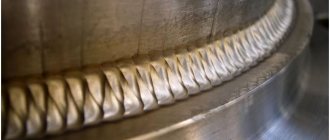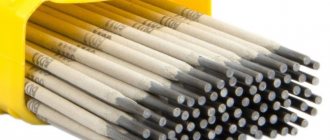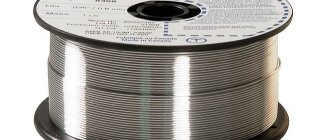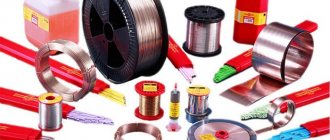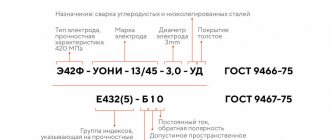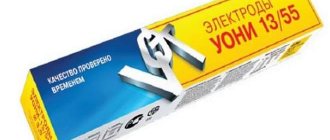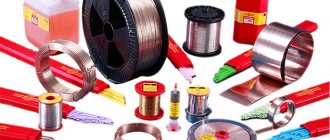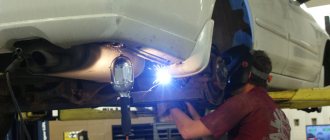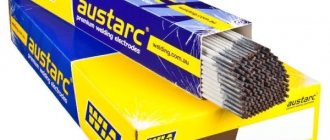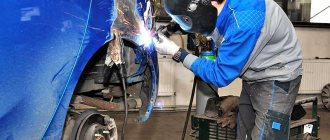Instructions for the preparation and storage of welding materials RD 34.10.124-94 (page 2)
1) Electrodes can be calcined no more than three times, not counting the initial calcination during their manufacture. If the electrodes after three calcinations show unsatisfactory welding and technological properties, then their use for welding work is not allowed.
2) The number of calcinations of flux-cored wire and flux is not limited.
3) The maximum deviation from the calcination duration is +0.5 hours.
4) Table PTM-1c-93 was supplemented by the developer of this instruction with AN-26S grade flux, intended for welding joints of parts made of austenitic steels.
3.5 Calcination of electrodes, flux-cored wire and fluxes must be carried out in calcining electric furnaces of any design, from among those produced by the domestic industry, providing calcination modes specified by standards, technical specifications for welding materials and PTM-1c-93.
3.6 Calcination of fluxes should be carried out on baking sheets made of heat-resistant stainless steel. Flux calcination modes must be controlled by thermocouples installed directly in the flux layer. It is allowed to control the calcination mode of fluxes with furnace (roof) thermocouples after calibrating them using thermocouples installed in the flux. The calibration chart (table) must be located at the workplace where calcination is performed. The calibration schedule (table) must be signed by the welding supervisor, the person who performed the calibration, as well as a representative of the technical control service of the enterprise (organization).
3.7 The height of the flux layer when calcining fluxes of brands AN-26S, AN-42, AN-42M should not exceed 200 mm, fluxes of grades OSTS-45, OSTS-45M, AN-348A, AN-348AM, ANTs-1, FTs-11 , FC-16, FCmm.
3.8 During calcination, the electrodes are placed on grids. installed in electric furnaces, in layers no more than 200 mm high for electrodes with a main coating and no more than 300 mm high for other electrodes.
3.9 When loading coated electrodes, flux-cored wire and fluxes into an electric furnace, an entry is made in the “Welding Materials Calcination Log” indicating the brand, size, batch of welding material and quantity.
To control the material being calcined and to avoid mixing up materials, it is recommended to place a stainless steel tag in the furnace along with the material, which indicates the brand, size and batch of the material, or a label(s) from the packages of welding materials loaded into the furnace; keep it at the workplace until the end calcination
3.10 The date and mode of each calcination, as well as the serial number of calcination of a batch of welding material or its parts must be recorded in the “Record of calcination of welding materials”.
3.11 Wire with a non-copper-clad surface used for argon arc welding with a non-consumable electrode, gas welding, mechanized submerged arc welding and shielding gas welding with a consumable electrode, before being put into production must be cleaned of grease, scale, traces of rust to bare metal and degreased with a solvent (acetone , white spirit, rectified alcohol).
The surface of the wire can be cleaned mechanically on specialized machines or manually with sandpaper. It is allowed to strip the wire chemically, followed by washing and drying, for example, by etching in a 5% solution of hydrochloric or inhibited acid (3% solution of hexamine in hydrochloric acid). When cleaning wire intended for automatic welding, do not allow it to be sharply bent (fractured).
3.12 It is recommended that winding wire into cassettes (for mechanized welding) and cutting wire into measured pieces after stripping be done centrally. Wire stripped and wound into cassettes, as well as wire chopped and packed into bundles are stored in the pantry. A label indicating the size, brand and batch number of the wire must be attached to cassettes and bundles of wire prepared for use. Rewinding of cored wire is prohibited.
Note - It is allowed to strip, wind into cassettes and cut the wire before performing work by a welder who will use the wire when welding production or control joints (seams).
3.13 Before welding, tungsten electrodes (rods) must be cut with an abrasive wheel into small measured pieces, followed by sharpening the working end according to the instructions in the production and technical documentation, which must indicate the angle (length) of the sharpened part and the size of the blunting of the working end.
Cutting and sharpening of tungsten electrodes is carried out either by a specially designated person (storekeeper or other person) or by a welder who uses electrodes when welding production (control) joints (seams).
4 STORAGE OF WELDING CONSUMABLES
4.1 Welding materials should be stored in original packaging, sorted by brand, diameter and batch, in the storeroom(s) of the enterprise (organization). The storeroom(s) for storing welding materials must be located indoors (the use of mobile trailers or booths is permitted) and equipped in accordance with the instructions given in 2.2.3.
4.2 Coated metal electrodes after calcination before use should be stored:
1) in drying cabinets or stationary thermal cases at a temperature of 80 ± 20 ° C;
2) in a rigid, dense container, closed with a lid with a rubber seal;
3) in storerooms at an ambient temperature not lower than +15 ° C and at a relative humidity of not more than 50%.
4.3 Welding fluxes after calcination should be stored:
1) in drying cabinets on stainless steel trays;
2) in a rigid, dense container, closed with a lid with a rubber seal;
3) in storerooms at an ambient temperature not lower than +15 ° C and at a relative humidity of not more than 50%.
4.4 Flux-cored wire after it has been calcined should be stored under conditions similar to those given in 4.3, with the exception of the requirements for baking sheets.
4.5 Shelf life of electrodes, cored wire and fluxes after calcination:
1) when stored in drying cabinets, thermal cases, in sealed containers (jars and containers closed with lids with a rubber seal) - not limited;
2) when stored in storerooms (see 4.2-4.4) - limited and should not exceed the following periods:
a) for electrodes with a basic coating intended for welding pearlitic steels - 5 days, for other electrodes - 15 days;
b) for flux-cored wire - 5 days;
c) for flux - 15 days.
4.6 In the event of a decrease in air temperature below +10 ° C and/or an increase in air humidity above 50% in the storage room for calcined (dried) welding materials, the latter (from those that were not stored in ovens at a temperature of 60-100 ° C or hermetically sealed containers) are subject to verification of welding and technological properties. In the event of a power outage and electric furnaces for storing calcined welding materials being turned off for a period exceeding 12 hours, the latter are also subject to testing of welding and technological properties. When checking the welding-technological properties of welding materials, the influence of changes in temperature and/or humidity on the porosity in the deposited metal of a weld bead 100+20 mm long is determined, which is subject to control by radiographic method or visual and measuring methods during layer-by-layer grooving (gouging) of the weld surface (depth removed layer up to 1 mm) on machines or seam fracture.
The decision on the further use of these welding materials, taking into account the results of testing the welding and technological properties, is made by the welding supervisor.
4.7 At places where calcined coated electrodes, flux-cored wire and fluxes are stored in storerooms, in order to more completely and clearly record information, it is recommended to install plates (labels, tags, labels) indicating the brand of material, diameter, batch number, quantity, registration number according to the “Accounting Journal” calcination of welding materials”, dates of previous and last calcination (see examples of records). The plate (label, tag, label) is retained until the calcined materials are completely used or until the expiration of the shelf life. Upon expiration of the storage period or after complete use of the calcined materials, the plate is destroyed.
An example of an entry on a plate (tag, label) for coated electrodes
| UONII - 13/55, Æ3 | ® brand, diameter | ||
| P 698 | ® party | ||
| 19 | 31 | 57 | ® registration number in the “Register of calcination of welding materials” |
| 150 | 72 | 26 | ® quantity (kg) during the next calcination |
| 10.05.94 | 16.05.94 | 22.05.94 | ® date of calcination |
| ¯ | ¯ | ¯ | |
| first calcination | second calcination | third calcination |
An example of an entry on a plate (tag, label, tag) for welding fluxes (cored wire)
| AN-348 A | ® brand, (diameter) | ||
| 1428 | ® melt (batch) | ||
| 17 | 57 | 76 | ® registration number in the “Register of calcination of welding materials” |
| 98 | |||
| 450 | 300 | 150 | ® quantity (kg) during the next calcination |
| 60 | |||
| 17.05.94 | 02.06.94 | 18.06.94 | ® date of calcination |
| 10. | |||
| 04.07.94 |
Welding electrodes, upon expiration of the storage period after the last (third) calcination, must be removed to the insulator. These electrodes are not subject to further use for welding joints of equipment, vessels and pipelines, which are subject to the requirements of the rules of the State Mining and Technical Supervision of the Russian Federation (see 1.1). The possibility of further use of these electrodes and the area of their use is decided by the welding supervisor.
4.8 Employees of the enterprise (organization) responsible for storing calcined electrodes, flux-cored wire and fluxes must monitor the temperature and humidity in the room at least twice a day (every 8-12 hours), as well as the temperature in ovens (drying cabinets) and record readings in temperature logs, indicating the date and time the readings were taken. The entry in the journals is certified by the signature of the person who carried out the control, indicating the last name, first name, and patronymic.
4.9 Calcined electrodes, flux-cored wire and fluxes should be stored separately from non-calcined materials, for example, on separate racks to prevent mixing of calcined and non-calcined materials.
4.10 At workplaces, it is recommended to store electrodes in thermal cases or drying cabinets, and flux-cored wire and welding fluxes - in cans and containers, closed with lids with rubber seals, or drying cabinets.
Note - It is allowed to store calcined electrodes, flux-cored wire and fluxes at workplaces during one shift in conditions other than those specified, for example, in unheated canisters and containers (cans) without a sealed seal. In this case, storage areas must be protected from precipitation.
4.11 Tungsten electrodes at the welder’s workplace should be stored in wooden, metal or plastic cases.
4.12 Cylinders with protective gases (argon, carbon dioxide, oxygen, acetylene, mixtures of gases) must be stored in special warehouses or in open areas under a canopy that protects the cylinders from precipitation and direct sunlight.
Cylinders with protective gas of the same type, but from different delivery batches, must be stored separately from each other. It is recommended to mark cylinders of the same batch with the same symbol in chalk.
4.13 Guaranteed storage periods for welding materials from the date of manufacture should be:
| — coated metal electrodes: | |
| in sealed packaging | - 6 months |
| in unsealed packaging | — 3* months |
| - cored wire | — 8 months |
| — flux welding activating pencil of brands VS-2EK, VS-31K | - no more than 1 year |
| — tungsten rods (electrodes): | |
| SVI-1 (polished) | - 6 months |
| SVI-1 (forged) | - 12 months |
| - argon gas | - 18 months |
| — liquid carbon dioxide in cylinders | — 24 months |
| - oxygen gas | - 18 months |
| - acetylene in cylinders | - 6 months |
________________
* The terms are indicated for electrodes manufactured in accordance with OST 59370. For other welding materials, warranty storage periods are not regulated by the current regulatory and technical documentation (standards, technical conditions).
4.14 After the expiration of the guaranteed storage period, welding materials must be used only after checking their condition and welding-technological properties. The inspection is carried out by a commission of the enterprise (organization) in accordance with the “Instructions for the control of welding materials and materials for flaw detection.”
5 ACCOUNTING OF WORK WITH WELDING MATERIALS AT THE ENTERPRISE
5.1 The receipt and consumption of welding materials are subject to accounting. The responsible person (storekeeper) of the enterprise (organization) takes into account:
1) receipt of welding materials at the consumer’s warehouse (storeroom);
2) preparation of welding materials if their preparation is carried out in parts;
3) release for production;
4) return of unused electrodes, fluxes, wire, activating fluxes.
5.2 Receipt of welding materials is recorded in the “Record of Receipt of Welding Materials”* (Appendix B).
5.3 The preparation of welding materials is recorded in the “Record of calcination of welding materials”* (Appendix D).
5.4 The issue of welding materials is recorded in the “Logbook for the issue of unused welding materials for production and return”* (Appendix D).
Covered electrodes, flux-cored wire and welding fluxes not used during the shift, if they were not stored in thermal pads, drying cabinets and sealed containers at the workplace, must be returned to the storeroom. The fact of return is recorded in the “Logbook for the release into production and return of unused welding materials.”
It is allowed to divide the “Logbook for the release into production and return of unused welding materials” into two separate journals: “The Logbook for the issue of welding materials into production”* and “The Logbook for the return of unused welding materials.”*
5.5 The temperature and humidity of the air in the storeroom for storing calcined welding materials is recorded in the “Logbook for recording the temperature and humidity of the air in the storeroom for storing calcined welding materials”* (Appendix E), and the temperature in furnaces (drying cabinets) - in the “Logbook for recording temperature in electric furnaces when storing calcined welding materials"* (Appendix G).
________________
* Magazines must be bound and the pages in them must be numbered
5.6 Electrodes, flux-cored wire and flux returned to the warehouse must be stored separately from calcined materials that were not delivered to the work site. Reuse of these materials is permitted after their next calcination.
5.7 Welding materials are issued at the request of the engineer and technical worker supervising welding work at the facility, product, equipment or pipeline (Appendix 3).
5.8 When issuing welding materials to the work site, the following is checked:
1) when issuing coated metal electrodes - brand, diameter, distinctive coloring of the ends or coating color, date of calcination;
2) when issuing welding fluxes - brand, color, date of calcination;
3) when issuing flux-cored wire - brand, diameter, surface cleanliness, date of calcination;
4) when issuing welding wire and tungsten electrodes - brand, diameter, surface cleanliness,
5) when issuing activating flux - brand, color;
6) when dispensing protective gas (in cylinders) - the color of the cylinder, the inscription on the cylinder, the presence of a label (label).
Note - Materials are issued in the volume specified in the “Requirements for the release of welding materials into production” (see 5.7).
5.9 If, when the welding wire is released into production, a coil of wire is divided into several separate coils, then a metal label must be attached to each coil containing data identical to the data indicated on the label of the whole coil of welding wire.
5.10 Electrodes and wire intended for welding joints of parts made of austenitic steels, high-chromium steels, welding joints of parts made of pearlitic steels with parts made of austenitic steels, as well as welding cladding layers of bimetallic materials, should be monitored with a portable magnet or on a magnetic table for absence among them are ferritic materials.
5.11 When issuing electrodes, welding fluxes and wires into production, the person receiving the materials is issued a “Welding Material Certificate” (Appendix I), which indicates:
1) number of the request for the release of material;
2) brand and size of material;
3) date of calcination;
4) the amount of material issued;
5) date of issue.
The certificate is signed by the person who issued the welding materials for production.
The certificate is stored at the welder’s workplace as a document confirming the quality of the material.
The certificate is returned to the storeroom at the end of the shift along with the welding material unused during the shift, and in case of complete use, with a mark of use.
Note - The calcination date in the “Certificate for welding material” is indicated provided that the material is stored in the storeroom (see 2.2.3). When storing calcined materials in an oven at a temperature of 80±20 °C or in a sealed container, the date of calcination may not be indicated.
6 TRANSPORTATION OF WELDING MATERIALS TO THE SITE OF WORK
6.1 Calcined electrodes, flux-cored wire and fluxes, as well as welding wire and tungsten electrodes are delivered to the welder’s workplace in containers, packaging, and canisters. During transportation, conditions must be observed to ensure the safety of the packaging and protect welding materials from exposure to precipitation and contamination.
6.2 Cylinders with protective gases are transported to the work site by all means of transport in accordance with the requirements of the “Rules for the design and safe operation of pressure vessels” approved by the State Technical Supervision Authority of Russia. It is allowed to deliver protective gas cylinders over short distances using hand trucks or stretchers.
7 CONTROL OF PREPARATION, STORAGE AND ISSUE OF WELDING CONSUMABLES FOR PRODUCTION
7.1 Control of work on recording the receipt, preparation, storage and delivery of welding materials to work sites is carried out in order to confirm their compliance with the requirements of standards and technical specifications for welding materials, PTM-1c-93, production and technological documentation and these instructions.
7.2 Control of the preparation, storage and release of welding materials into production is carried out periodically, but at least once a week, by the head of welding work of the enterprise (organization), as well as by engineering and technical workers and inspectors of the welding and technical control services of the enterprise, whose duties according to their official duties instructions include this type of work.
7.3 When monitoring according to 7.2, the following are subject to inspection:
a) compliance of storage conditions (before and after calcination) with the requirements of these instructions, including at workplaces;
b) the correct preparation of materials before release into production;
c) registration of the results of preparation, storage and release of welding materials into production.
7.4 When monitoring storage conditions, the following parameters and indicators are visually monitored:
7.4.1 Before calcination (drying) of welding materials:
1) checking the presence of markings (labels, tags, labels) on each packaging item (box, bundle, box, coil, etc.);
2) cleanliness of the room (no excessive dust), proper ventilation, glazing of window openings, no leaks, no materials in the storeroom that contribute to corrosion of metal welding materials, for example, acids;
3) absence of contamination and traces of corrosion on the surface of the welding wire and electrode rods;
4) the absence of visible traces of mixing electrodes and wires, which should be stored in the storeroom, sorted by batches (melts), materials supplier plants, standard sizes;
5) the condition of the labels (tags) and the legibility of the signatures on them; if signatures fade, become dirty, etc., the storekeeper is obliged to take measures to restore them;
6) the condition of the electrode coating, especially the cellulose type (no signs of color change, “precipitation of salts,” etc.).
Inspection of welding materials before their calcination is carried out selectively. The sample size is set by the person performing the control, but, as a rule, should not be less than 5%.
7.4.2 After calcination (drying) of electrodes and fluxes:
1) the temperature and humidity of the air in the pantry, as well as the serviceability of instruments for monitoring these parameters (thermometer and psychrometer);
2) temperature and storage conditions of calcined materials in drying cabinets, serviceability of temperature control devices;
3) the tightness of the closure of sealed containers for storing calcined flux;
4) the presence of plates (tags, tags, tags) confirming the brand, size, batch (melting), calcination of the material and its date, which are located on the rack or closed container where calcined welding materials are stored;
5) the procedure for storing calcined welding materials, which must be stored separately from non-calcined ones.
In addition, when monitoring welding materials after calcination, the indicators (parameters) given in 7.4.1, items 3-5 are checked.
It is recommended to combine control according to 7.4.1 and 7.4.2.
7.5 Monitoring the correct preparation of welding materials includes checking the following parameters and indicators:
1) checking the calcination (drying) mode of the welding material, which is performed according to the indicators of calcining electric furnace devices;
2) checking the loading of the furnace with welding materials and the correct installation of thermocouples (see section 4);
3) serviceability of electric furnaces, control and measuring equipment and thermocouples (thermoelectric converters).
The entire calcination cycle (load, temperature, duration) is controlled.
7.6 Control of registration of the results of preparation, storage and release of welding materials into production is carried out according to entries in the relevant journals (see section 5). The correctness of keeping logs and the regularity of making relevant entries in them is checked.
7.7 The fact of carrying out the next inspection is recorded in the logs indicating the identified deficiencies and measures to eliminate them. The record of the inspection results is certified by the signature of the inspector indicating his position, surname, first name and patronymic, and the date of the inspection.
7.8 Control of the storage of materials at welding workplaces is carried out every shift by line engineering and technical workers and/or inspectors of the technical control service (department, bureau), authorized to carry out inspections by job descriptions.
When monitoring the storage of welding materials at workplaces, the compliance of storage conditions with the requirements of regulatory, technical and production-technological documentation for welding materials and the welding process of the product is checked. When inspecting calcined electrodes, welding flux and flux-cored wire, special attention should be paid to the presence of special containers (pencil cases, boxes, bags, containers, etc.) or drying cabinets that prevent moisture and contamination of materials. When monitoring the storage of welding materials, attention should also be paid to excluding the possibility of using welding materials for welding that are not used for welding joints of a given unit, for example, electrodes of the type UONII-13/55, TSU-5, TMU-2U when welding pipe joints of heating surfaces made of steel grade 12Х1МФ, etc. Electrodes, flux, wire issued to the welder for welding connections of another unit must be stored separately from those used in welding this welded unit.
7.9 Welding materials are written off in the following cases:
1) lack of accompanying documentation and/or markings on the packaging;
2) destruction of the electrode coating;
3) expiration of the storage period after the final (from among the permitted) calcination;
4) receiving negative results of quality control of welding materials in accordance with the “Instructions for the control of welding materials and materials for flaw detection.”
The write-off of welding materials according to listings 1, 2 and 4 is carried out by the logistics department upon written submission from the head of welding works of the enterprise (organization), and according to listing 3 - by the head of welding works of the enterprise.
Note - When writing off welding materials for the reasons specified in listings 1, 2 and 4, a complaint report must be sent to the manufacturer of the material indicating the identified deviations from the standards and specifications.
8 SAFETY REQUIREMENTS
8.1 Safety measures in relation to local working conditions must be developed by the enterprise using welding materials in accordance with the current regulatory and technical safety documentation in the industry: SNiP III-4-80, GOST 12.0.004, GOST 12.1.004, GOST 12.1.019. GOST 12.1.005, GOST 12.1.007.
Safety measures must be approved by the head of the enterprise.
| Due to the large volume, this material is placed on several pages: 2 |
Shielding gases
Protective gases are stored and transported mainly in cylinders with a capacity of 40-50 dm3 (liters) at a pressure of 15 MPa, and liquid carbon dioxide - up to 6 MPa. To protect against corrosion and quickly identify the cylinders, in accordance with the requirements of GOST 949-73, they are painted in different colors and have appropriate inscriptions. Along with the bottled supply of shielding gases to welding stations, gasifier tanks for carbon dioxide, argon and oxygen are used. Gases are pumped into special storage facilities, from where the gases are transported through pipelines to workplaces. The pipelines are painted in colors similar to the colors of the cylinders. However, where high gas consumption is not required, a traditional cylinder power system is used for welding stations and for ramp power supply of small workshops or areas. Transportation of gases is carried out in compliance with instructions regulating the qualifications of a special driver: limited-time parking; maintaining a certain pressure during forced and emergency stops and other special conditions associated with the operation of special tank trucks.
Shelf life of electrodes
Specialists who often perform welding work stock up on a large number of electrodes. Because it is more profitable to buy welding materials at wholesale prices rather than at retail prices. In order for the finished product to be manufactured at a high level, consumables must be of high quality.
Depends on storage conditions
To ensure the quality of the electrodes, it is necessary to store them in optimal conditions :
- the room must be dry, heated in winter, and have waterproofing ;
- the temperature should not fall below 14 degrees ;
- Constant humidity should not exceed 50% . To control this indicator, it is necessary to use air conditioners.
The production date of OK 46.00 electrodes is indicated on the packaging
What you need to know about aluminum consumables
Their main area of application is semi-automatic welding in an inert gas environment in the automotive and shipbuilding industries, as well as the food industry. The object is alloys of aluminum with magnesium, manganese, silicon, and the weld is characterized by high strength and corrosion resistance.
All this is true if the material is stored in a sealed package: after opening, its surface instantly oxidizes. The oxide layer makes welding difficult, since the melting point of the latter is several times higher than that of pure aluminum. Therefore, the product must be protected from oxidation and moisture, and the resulting coating must be removed before starting work. Compliance with all these rules will preserve the performance characteristics of each variety.
